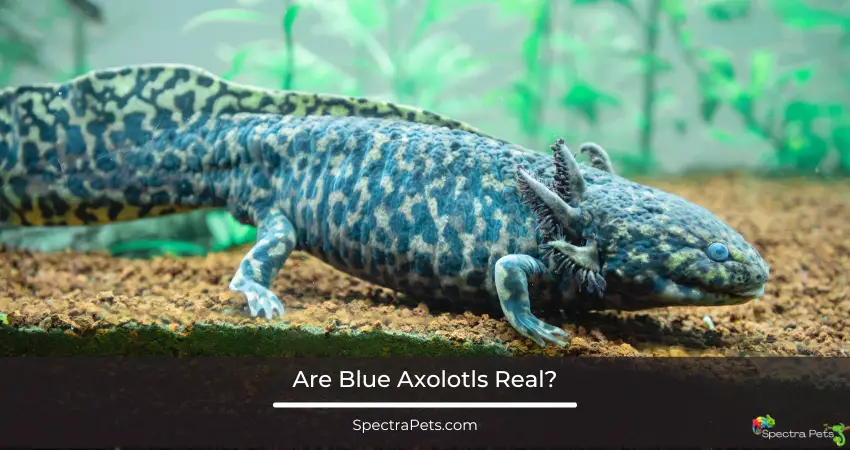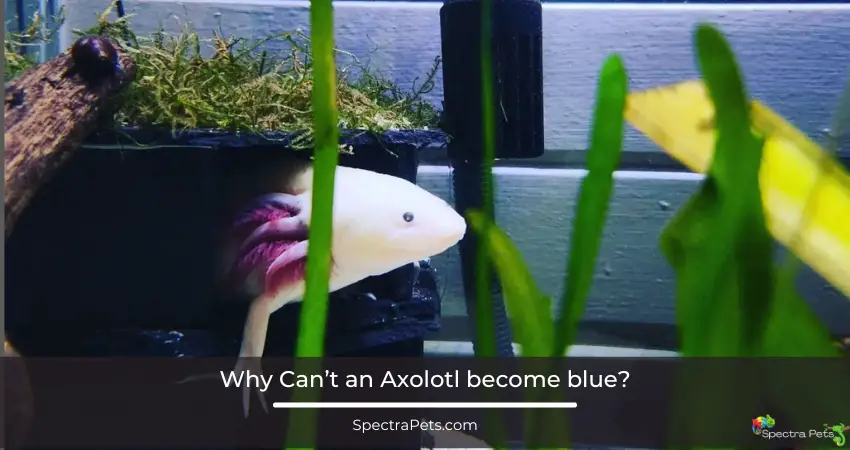Axolotls are truly unique and mesmerizing creatures. They are a type of salamander that is native to Mexico and are often kept as pets due to their docile nature and interesting features. Their smooth and shiny skin, delicate gills, and small yet soulful eyes make them a captivating sight to behold. They possess an otherworldly beauty that is both graceful and curious.
Now you might have seen some stunning pictures or videos of blue axolotls on the internet which look absolutely fantastic. But, unlike what you might expect, blue Axolots don’t exist in real life. In fact, there is no possibility of finding any blue axolotl in nature as they have no blue color-producing Chromatophores in their skin.
Now, it is worth asking why the Axolotls appear blue in those images and videos. Keep reading and I hope you get your answer with some astounding information too.

What determines the color for Axolotls: Roles of chromatophores
Before diving into the details of axolotls’ skin coloration, you should have a clear idea about the function of chromatophores in aquatic animals. There are six types of chromatophores that occur in aquatic animal species, each responsible for producing different colors and patterns on their skin.
These six types are melanophores, xanthophores, erythrophores, leucophores, iridophores, and cyanophores.
- Melanophores are responsible for producing black and brown colors. They contain melanin pigment, which is dark in color and absorbs light, making it ideal for producing darker colors.
- Xanthophores produce yellow and orange colors. They contain carotenoid pigments, which are light-absorbing and reflect yellow and orange wavelengths of light.
- Erythrophores produce red colors. They also possess carotenoid pigments, responsible for their red color.
- Leucophores produce white colors. They contain uric acid, which reflects light and gives a reflective appearance.
- Iridophores produce iridescent colors. These contain reflecting platelets made from guanine, which create a prism-like effect, causing colors to appear to change depending on the angle of light.
- Cyanophores produce blue and green colors. These chromatophores reflect blue and green wavelengths and animals containing Cyanophores will appear blue or green.
So, the different types of chromatophores allow aquatic animal species to produce a range of colors and patterns, which play an important role in communication, camouflage, and defense against predators. Let’s see why an axolotl can’t appear blue biologically:
Why Can’t an Axolotl become blue?
An Axolotl cannot become naturally blue because they lack the necessary pigments to produce blue coloration in its skin. Axolotls have three types of pigments in their skin: melanophores, iridophores, and xanthophores.
You already know that Melanophores produce black and brown colors, iridophores produce iridescent colors, and xanthophores produce yellow and orange colors. None of these pigments are capable of producing blue coloration.
If an axolotl’s skin contains pigment cells called “Cyanophores”, then you would be able to find blue ones in nature. But, unfortunately, there is no scientific evidence that Cyanophores cells exist on axolotls. So, you can now easily understand why they can’t appear blue.

While these creatures are not naturally blue, they are still fascinating and unique animals that have captivated people’s attention for centuries with their regenerative abilities, adorable appearance, and interesting behaviors.
However, if you see an axolotl that appears to be blue, it is likely that the color has been artificially applied through dyeing or photo editing.
The Truth About Blue Axolotls
Axolotls come in a range of colors, including pink, white, black, and brown. However, blue is not one of their natural colors. As mentioned earlier, Axolotls have cells in their skin called chromatophores, which are responsible for producing colors and there are no chromatophores that produce blue pigments in axolotls.
Despite this, many people believe that blue axolotls exist. There are several factors that contribute to this misconception and now I’ll discuss them elaborately so that you can have a better understanding. Here are the reasons:
1. Under certain lighting conditions
One reason why some axolotls may appear blue is due to lighting. The way that light interacts with an axolotl’s skin can influence its coloration. This is because axolotls, like many other animals, have iridophores in their skin that reflect light to produce different hues.
Under certain lighting conditions, the iridophores in an axolotl’s skin can reflect blue light, making the axolotl appear blue. This effect can be particularly pronounced in axolotls that have a lot of white or light-colored skin. The blue appearance may also be enhanced by the presence of black pigmentation, which can create a contrast that makes the blue coloration more noticeable.
It is important to note that the blue coloration caused by lighting is temporary and can change depending on the lighting conditions. Additionally, lighting can only produce a blue appearance in axolotls that have a certain amount of iridophores in their skin. Axolotls that do not have enough iridophores or have different pigments in their skin will not appear blue, even under the right lighting conditions.
2. Due to camera distortion
It is not uncommon for cameras to struggle with accurately representing the colors of a real-life scene, and as a result, images may appear different than what is actually observed. In some instances, this may lead to the false perception that an axolotl is blue, despite its actual coloration.
Another potential explanation for an axolotl’s blue appearance is due to the limitations of cameras in accurately capturing true colors. The way in which cameras capture images can sometimes result in distorted colors that do not reflect the true appearance of the animal.
3. Due to the use of blue dye
Although some people may find it tempting to dye their axolotls to achieve a blue hue, it is essential to consider the potential consequences before doing so. In my opinion, this practice is not advisable, and I would like to explain why.
First of all, dyeing can have a severe impact on the health of these amphibians, which can lead to long-term suffering. The toxins in the dye can harm the axolotls and cause health problems that may not be easily rectified.
Moreover, dyeing can pollute the water in the tank, making it difficult to maintain the ideal environment for the axolotls. Changing the water can be an arduous task, and it is not something that anyone would want to do regularly.
Due to this, it is crucial to think twice before dyeing your axolotls. While the method may be intriguing, the risks far outweigh the benefits, and it is not worth compromising the health and well-being of your beloved pets.
4. Using Photo and Video Editing Software
There are some photographs and videos of axolotls appearing blue, which have been created by using photo and video editing software. The purpose of such edited images may vary, ranging from simple aesthetic pleasure to deceiving people about the existence of blue axolotls.
While it’s true that the use of photo and video editing software can provide unique and visually appealing images of blue axolotls, it’s important to remember that these images are not reflective of the animal’s natural appearance.
Additionally, the proliferation of edited images of blue axolotls can perpetuate a harmful belief that these creatures should naturally appear blue. This expectation can lead to many problems.
Therefore, it’s important to appreciate the natural diversity of these cute aquatic guys and avoid creating unrealistic expectations for their appearance. While edited images can be a useful tool for creative expression, it’s essential to use them responsibly and ensure that they don’t contribute to harmful practices.
What is the safest way to make your Axolotl appear blue?
To make your axolotl look blue, you can use multiple-colored LEDs in your aquarium with a dim setting. Here’s how:
- Purchase blue-colored LED lights or a combination of blue and white-colored LED lights. You can find these lights at most pet stores or online.
- Install the LED lights in your aquarium according to the manufacturer’s instructions. Make sure to place them in a way that evenly distributes the light throughout the tank.
- Turn on the LED lights and adjust the dimming setting to a low level. This will create a soft, blue glow in the aquarium and help your axolotl look blue.
- Monitor your axolotl’s behavior and health to make sure it’s not being negatively affected by the new lighting. Axolotls prefer low-light environments, so make sure the LED lights are not too bright.
- Adjust the lighting as needed. If the light is too bright, adjust the dimming setting or add a filter to reduce the brightness. Enjoy the new blue look of your axolotl.
Are Purple Axolotls Real or Just a Myth?
Discover the truth about purple axolotls with these fascinating purple axolotl facts revealed. Axolotls are captivating creatures native to Mexico and known for their regenerative abilities. While most axolotls are typically shades of brown, there have been claims of rare purple variants. However, these alleged purple axolotls remain a topic of debate among experts, leaving their existence as either real or simply a myth.
Final Words
It is important to note that blue axolotls do not exist naturally in the wild. While photographs and videos may depict axolotls with a blue hue, this coloration is not a natural occurrence. Rather, unethical dyeing practices or artificial lighting conditions are often responsible for the coloration.
It is important to note, however, that any modifications made to the aquarium environment should prioritize the health and comfort of the axolotl. The natural coloration of axolotls is an important aspect of their biology and should be respected and appreciated. Any attempts to alter an axolotl’s appearance should prioritize the animal’s well-being and be done with caution and consideration.
